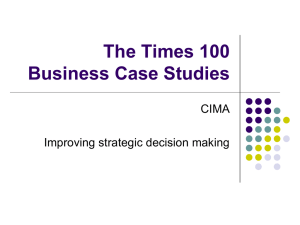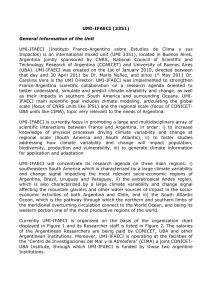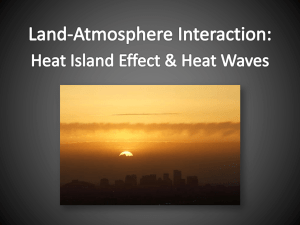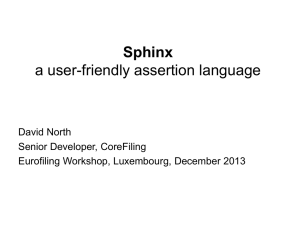Research Staff - Centro de Investigaciones del Mar y la Atmosfera
advertisement
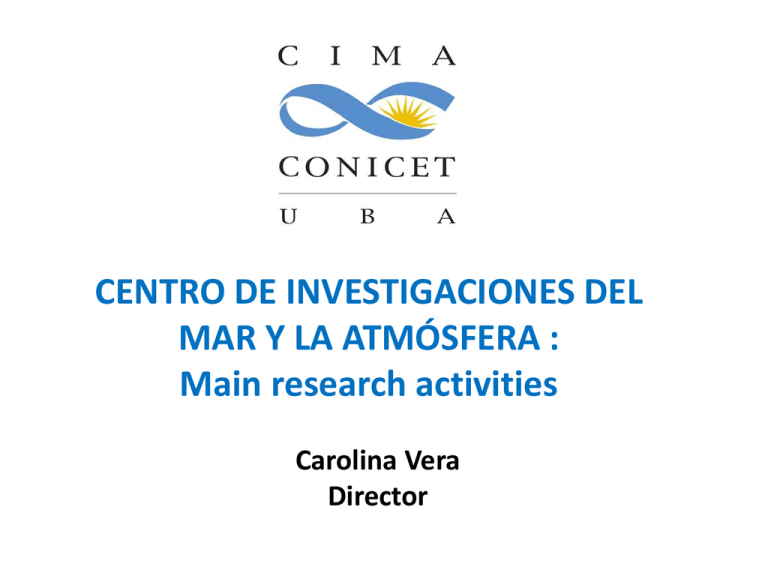
CENTRO DE INVESTIGACIONES DEL MAR Y LA ATMÓSFERA : Main research activities Carolina Vera Director •CIMA is a joint Research Institute between the National Council of Scientific and Technical Research (CONICET) and the University of Buenos Aires (UBA). •CIMA is one of the CONICET-UBA Institutes located in the School of Exact and Natural Sciences (FCEN). •CIMA has a strong interaction with the Department of Atmospheric and Ocean Sciences of UBA/FCEN. Most of CIMA researchers are Professors or Professor Assistant at the Department. STAFF: •The staff at CIMA is comprised of CONICET Researchers, UBA Professors and Professor Assistants, CONICET Technical/Administrative employees, graduate and undergraduate students under fellowships supported by different institutions, and contracted employees. •Currently CIMA includes 19 Researchers, 25 postgraduate, graduate and undergraduate students, and 8 technical/administrative employees. Mission Statement: •To expand the knowledge of the physical processes controlling and determining the behavior of both atmosphere and ocean, in the context of the earth system. •To contribute to the formation of future researchers and technicians. •To promote the transference of both knowledge and technology for society benefit. CIMA Modeling activities: •Numerical modeling related activities have been the distinctive feature of CIMA since its creation. •Currently CIMA is the research institute in Argentina with the largest amount of researchers with expertise on numerical modeling of both atmosphere and ocean. •CIMA facilitates the computing facilities and technical support needed for modeling activities. RESEARCH STRATEGY Applications REGIONAL FOCUS ON: Modeling Analysis and Process Studies SOUTHERN SOUTH AMERICA & SOUTH ATLANTIC Impact Studies Mesoscale Synoptic Intraseasonal Interannual & Decadal Climate Change Río de la Plata related processes Research Staff: C. Simionato, D. Moreira, M. L. Clara Tejedor From SHN (Argentina): W. C. Dragani, M. Fiore, E. D’Onofrio, P. Martin From INIDEP (Argentina): R. Guerrero, C. Lasta, M. Acha, H. Mianzán, A. Jaureguizar From IFREMER (France): F. Cayocca, P. Le Hir, F. Gohin, V. Garnier • • • To understand and to improve our capability of modeling the hydrodynamic and sedimentary processes in the Río de la Plata To understand the system response to climate variability and change To understand the relationship between the biological and physical processes in the estuary Monitoring the Rio de la Plata Pilote Norden Torre Oyarbide Oceanographic campaigns Models and observations are used to understand the impact of diverse forcings on the estuary variability at different time scales From Meccia, Simionato & Guerrero, submitted to Est Coast Shelf Sci Wind variability and runoff have a large impact on the SST in this shallow area From Simionato, Luz Clara, Campetella, Guerrero & Moreira. CSR in press Models are being used to understand the reasons that make this estuary retentive for fishes (and contaminants!) in cooperation with INIDEP From Simionato, Berasategui, Acha & Mianzan. Est Coast Shelf Sci 2008 Climate variability is being related to changes in other estuarine processes, as for instance, tidal propagation, in cooperation with SHN From Luz Clara, Simionato, D’Onofrio & Fiore, manuscript in preparation Deep moist convection in Argentina PI: Matilde Nicolini. Collaborators: Y. Garcia Skabar SMN- CONICET, P. Salio, M. Torres Brizuela –UBA, H. Ciappesoni SMN- CONICET, M. Suaya, V. Leis, C., SMN, M. A. Silva Dias - University of San Pablo , P. Leite Silva Dias, University of San Pablo, G. Raga UNAM, Mexico Objectives: • investigate the mechanisms controlling convection and to focus on short range prediction of these mechanisms. • to develop a weather forecast system in the storm scale to characterize convection in the north-central domain of Argentina, from two different strategies: an explicit deterministic prediction of convection with high resolution and an ensemble forecast that allows a probabilistic approach. 0,1 Mesoscale circulations east of the Andes 0,08 0,06 0,04 0,02 0 -0,02 -0,04 -0,06 a) 24 25 26 27 28 29 30 31 1 2 3 4 5 6 7 0,08 0,06 Div. Total 09 UTC Div. Zonal Div. Merid. 0,04 Mountain-plain breeze Diurnal cycle 0,02 0 -0,02 -0,04 -0,06 -0,08 -0,1 b) 24 25 26 27 28 29 30 31 1 2 3 4 5 6 7 0,1 21 UTC 0,08 0,06 0,04 0,02 0 -0,02 -0,04 -0,06 Div. Total Div. Zonal Div. Merid. -0,08 c) 24 25 26 27 28 29 30 31 1 2 3 4 5 6 7 Nicolini, M., Skabar, Y.G., Diurnal cycle in convergence patterns in the boundary layer east of the Andes and convection, Atmos. Res. (2010), doi:10.1016/j.atmosres. 2010.09.019. Development of techniques to calibrate and check rainfall estimates PI: Paola Salio, Collaborators: M. Nicolini, A. Hannart UMI –IFAECI, M. Hobouchian , Y. Garcia Skabar, L. Ferreira, L. Vidal, C. Matsudo, SMN. L. Toledo Machado (CPTEC – INPE), C. Angelis, D. Vila (DSA – INPE) , C. Morales (University of San Pablo), E. Zipser (U Utah), D. Cecil (U Alabama), I Zawadzki (Mc Gill University), F. Tapiador (University of Castilla La Mancha) Objectives 1. Develop a methodology that will make it possible to have reliable rainfall estimates from different observation sources in the Plata Basin and make these products available to different users. 2. Advance the characterization of deep moist convection over SESA. 3. Study the impact of mesoscale convective systems on rainfall over SESA and their impact on the diurnal cycle of rainfall. 4. Advance the knowledge on the mesoscale mechanisms that trigger and affect the evolution of organized deep moist convection and its impact on rainfall and possible generation of severe phenomena. Determination of strong convection and severe weather events considering remote sensing from microwave channels IR and LIS 85 GHz PCT Determination of strong MCSs Determinations of hail trails Determination of bias between of Ground Radars considering TRMM and disdrometers 60 60 60 Ezeiza 50 50 50 40 40 40 30 30 30 20 20 20 10 10 10 0 Paraná 0 0 0 10 20 30 40 50 60 0 10 0 20 10 30 20 40 30 50 40 60 50 60 Satellite altimetry contributions in the South Western Atlantic Ocean Improvements of satellite altimetry data over the Patagonian Shelf PI: M. Saraceno, Collaborators: Enrique D’Onofrio (SHN & DCAO), M. Fiore and W. Grismayer (SHN), Laura Ruiz Etcheverry (CIMA) Meso and large scale circulation in the SWA Ocean PI: M: Saraceno, Collaborators: Alberto Piola (SHN & DCAO), Christine Provost (LOCEAN, IPSL), Elbio Palma (UNS), Ted Strub and R Matano (COAS, OSU), Ana Julia Lifschitz (CIMA) Improvements of satellite altimetry data over the Patagonian Shelf Results The main limitation to use satellite altimetry data over the Patagonian shelf is accuracy of tidal models (Saraceno et al, CSR, 2010; Saraceno et al, JGR, 2008) Work in progress Further validation of along-track data and implementation of a regional tide model with data assimilation Fig. 1. Position of the Tide Gauges (magenta dots) and of the crossovers (circles) considered for the comparison between tide models and observed amplitudes and phases. Background: bathymetry (Smith and Sandwell,1997); diagonal lines correspond to the ascending and descending paths of the T/P and J-1 and J-2 missions; the eastern border of the shelf is represented by the 300m isobath( black contour). Meso and large scale circulation in the SWA Ocean Results Ocean circulation over the Zapiola Rise (45W,45S) shows large interannual variability (Saraceno et al, DSR 2009) Work in progress Contribution of mesoscale eddies to the Meridional Overturning Circulation in the Brazil-Malvinas Confluence region Figure 1: Colors indicate the bathymetry in the Argentinean Basin between 4500m and 6000m depth. Thin black lines indicate f/H isocontours (units –1x10-8 m-1s-1). The closed contours range from –2.1 x10-8m-1s-1 to –1.92x10-8m-1s-1. The mean positions [Saraceno et al., 2004] of the Subtropical Front (STF) and the Subantarctic Front (SAF) are indicated by solid black and solid red lines, respectively. The positions of these two fronts correspond, also respectively, to the southern limit of the South Atlantic Current and to the northern limit of the Antarctic Circumpolar Current. Vector speeds estimated from the trajectories of profilers pf3900111 (red arrows) and pf3900110 (black arrows) are indicated. The profiler starting points are indicated by solid dots. The vector scale (bottom-left corner) is common to both profilers. Synoptic systems associated with extremes events over southern South America Norma Possia and Claudia Campetella (PI’s), Alejandro Godoy (PhD student), Carolina Cerrudo (undergraduate student) Main objectives • to study the dynamical processes associated with extratropical upper level trough, particularly those who evolve to cut-off lows. • to diagnose the main physical mechanism related to the life cycle of upper level cut-off lows • characterize the temporal evolution of the 3D structure of coastal cyclones associated with extreme events (precipitation and/or wind storm surges, waves, floods) Cut-off Lows – Climatology and impacts 60% 50% 40% 30% 20% 10% 0% Percentage of seasonal rain associated to COLs Mendoza La Rioja SUMMER Parana Corrientes AUTUMN Iguazu 33 Orientales WINTER Buenos Aires Tres Arroyos Junin SPRING Percentage of COLs associated with a precipitation extreme (above the 75th percentile) for the total COLs affecting each station (including rain and no rain events) Trajectories of cut off lows affecting southern South America in 2000-2006. Intraseasonal variability in South America PI: Carolina Vera, co-PI: G. Kiladis, B. Liebmann (NOAA/ESRL) Collaborators: B. Cerne, M. Alvarez, P. González More relevant questions •Which are the most relevant mechanisms associated with the leading pattern of precipitation anomalies (seesaw pattern) South America on intraseasonal time scales (10-70 days)? • What is the interaction between the high-frequency perturbations and the MJO in central and eastern South Pacific? How much of the seesaw pattern variability is accounted by such interaction? •What are the links between interannual, intraseasonal and high-frequency variability over central and eastern South Pacific and South America regions? •How well do the current climate models reproduce the dominant mechanisms associated to variability over South America on intraseasonal timescales? Intraseasonal variability in South America 1st EOF leading pattern of 1090-day filtered OLR variability Weakened SACZ Intensified SACZ Intensified SALLJ poleward progression Inhibited SALLJ poleward progression L - T. H H SOUTH AMERICAN SEE-SAW PATTERN L - T. + T. ano m anom Higher frequency of extreme daily rainfall events at the subtropics (Liebmann, Kiladis, Saulo, Vera, and Carvalho, 2004) (Gonzalez, Vera, Liebmann, Kiladis, 2008) H L anom + T. ano m Higher frequency of heat waves and extreme daily temperature events at the subtropics (Cerne , Vera, and Liebmann, 2007, Cerne and Vera, 2010) Extremes Research staff: C. Menéndez, A. Carril, A. Anna Sörensson, R. Ruscica, P. Zaninelli •How does anthropogenic climate change influence the likelihood of occurrence of extreme weather/climate phenomena? •To what degree can we relate the regional changes in variability/extremes to changes in the large scale atmospheric circulation? •Advance understanding of the extreme event occurrence from a physical point of view. (e.g. do soil-atmosphere interactions influence extremes of precipitation and temperature?) CLARIS 1 multi-model ensemble (1991-2000) Taylor diagrams for 75th percentile of maximum and 25th percentile of minimum surf. air temperature in southern La Plata Basin TX, P75 r 0.8 0.9 2 Re Rc 0.95 L E P 2 2 1 0 1 1 D Re 1 D R M S 0.7 n Standard Deviation 3 3 0.99 REF e o n 0 r i o 1 4 0.95 E r 0.6 t i 0.9 2 o a t 0.8 L C l a Rc 0.4 e 0.7 3 0.3 0.5 l 4 r 0.6 4 5 o 0.1 0.2 R M S P 0.5 0 5 3 0.4 C 4 0.3 5 0.1 0.2 Standard Deviation 0 5 TN, P25 0.99 REF 1 Taylor diagrams for percentile 75 of maximum and percentile 25 of minimum temperature (TX and TN) for DJF and JJA respectively. These diagrams are used to quantify and visualize the overall correspondence between CLARIS FP6 simulations (L: LMDZ, P: PROMES, Rc: RCA3, Re: REMO, E: ensemble mean) and observational climatologies (REF: Tencer et al 2010). Each model performance relative to the reference climatology is visualized by a point on the plot. Each point gives information on three basic statistics: correlation coefficient between modeled and observed data, standard deviation of simulated data, and RMS difference between simulations and the reference data. Change in the risk of a daily precipitation extreme event for 2080-2099 (RCA3 driven by ECHAM5-OM) # # Areas in blue: the likelihood of occurrence of days with extreme rainfall increases by a factor of 2-3 during 2070-2099 To calculate the risk, we first calculate the percent of wet days for the period 20802099, that exceeds the present day 95th percentile. The risk of exceeding the present day extreme rainfall is obtained by dividing this fraction with 5 (since the risk of in present climate is 5 %). Sorensson et al., 2010, Met.Z. Decadal variations in La Plata Basin and their relationship with large-scale patterns Research Staff: C. Vera, G. Silvestri, A. Hannart Interdecadal Variability (20-35 years) Standardized anomalies of precipitation anomalies and SST principal components Soil-atmosphere interactions Research Staff: C. Menendez, A. Sorensson, R. Ruscica, A. Carril, P. Zaninelli •To contribute to a better understanding of the physical processes associated with soil-atmosphere interaction that govern the regional climate of the La Plata Basin. •Are there particular regions of strong interaction soil moisture-atmosphere in southern South America? Currently It is being evaluating the degree of soil moisture atmosphere interaction in the La Plata Basin, using ensembles of simulations performed with a regional climate model (RCA). We identified parts of SESA as a region of potentially strong coupling between soil moisture, evapotranspiration and precipitation through experiments with RCA (e.g. Sörensson & Menéndez, 2010, Tellus A). The product of evapotranspiration coupling strength and standard deviation of evapotranspiration (ΔΩE*σE). Dynamics of soil moisture conditions in southern South America Pi: C. Saulo, Collaborators: M. Seluchi (INPE/CPTEC), P. Spennemann, L. Ferreira (SMN), J. Ruiz, P. González Sensitivity and modeling studies are designed to answer the following: Which are the pathways for land-atmosphere coupling over our region of concern? Which mechanisms account for precipitation variability occurring as a consequence of changes in soil conditions: are they mostly related with local moisture recycling and/or with circulation changes? Which are the most significant oscillations of soil moisture from daily to intraseasonal scales? Circulation Precipitation SM ↓ SM ↑ SM ↓ Impact of soil moisture (SM) changes. Numerical simulations of a case study for Northwestern Argentina Low event during SALLJEX Soil Moisture Model implementation PI: M. Doyle 0.5 200 Near Surface (7 cm) 0.45 0.45 200 Middle Layer (20 cm) 180 180 0.4 0.4 160 160 0.35 0.35 140 140 0.3 0.3 120 0.25 100 0.2 80 120 0.25 Mod. Niv. 1 Med. 1 100 Mod. Niv. 2 Med. 2 0.2 0.15 60 80 0.15 60 0.1 40 0.1 0.05 20 0.05 0 0 1 7 13 19 25 31 37 43 49 55 61 67 73 79 85 91 97 103 109 115 121 127 133 139 145 151 157 163 169 40 20 0 0 1 7 13 19 25 31 37 43 49 55 61 67 73 79 85 91 97 103 109 115 121 127 133 139 145 151 157 163 169 Días 0.4 Días 200 Lower Level (60 cm) SImulated Obs 180 0.35 160 0.3 140 0.25 120 0.2 100 80 0.15 CLASS U3M 1D: Unsaturated moisture movement model is being callibrated in collaboration with the National University of Entre Rios Mod. Niv. 3 Med. 3 60 0.1 40 0.05 20 0 0 1 7 13 19 25 31 37 43 49 55 61 67 73 79 85 91 97 103 109 115 121 127 133 139 145 151 157 163 169 Días Test Site: Diamante – Entre Rios Province Simulations with NOAH soil model for La Plata Basin Research Staff: M. Nuñez, A. Rolla Climate Change projections: errors and reduction of uncertainties Research Staff: I. Camilloni, V. Barros, M. Doyle, G. Silvestri, P. Antico, R. Saurral, C. Gulizia, N. Montroul, E. Collini (SHN) • To determine the errors of GCMs in simulating the hydrologic cycle • • • • and moisture transport and convergence fields in South America To evaluate if GCMs represent or not heavy rainfall events To determine how GCMs represent the kinetic energy of disturbances in the atmosphere over middle and subtropical latitudes in South America According to previous results, to infer what processes are being misrepresented by GCMs To design corrective strategies of climate projections in the regions where possible Validation of the representation of the principal patterns of summer moisture transport in South America from the WCRP/CMIP3 dataset Observed 20 GCMs ensemble Convergence and moisture transport associated with extremes of PC1 Rainfall anomalies for extremes of PC1 Simulations of the hydrologic cycle of La Plata Basin from WCRPCMIP3 model outputs The hydrologic cycle of the La Plata Basin is simulated using the variable infiltration capacity (VIC) distributed hydrology model and forced with atmospheric data from different GCMs to determine to what extent errors in temperature and precipitation fields impact the hydrology of the basin. The skill assessment is performed in terms of simulated runoff at different closing points. Observed (dark solid line) and VIC simulations of the Uruguay River streamflow annual cycle VIC simulations results after application of an unbiasing scheme Validation of MRI/JMA Model in South America Research Staff: M. Nuñez, J. Blazquez MRI/JMA model ERA 40 reanalysis Mean 200 hPa wind intensity (shaded) and direction (arrows) for MRI/JMA model (left panel) and ERA40 reanalysis (right panel) for the period (1979-1999), DJF. High Resolution Global Model Performance over Southern South America. Blázquez & Nuñez (2010). Physical processes related with summer precipitation increase over La Plata Basin in climate change scenarios of GHG concentration increase Research staff: C. Vera, G.Silvestri, S. Gomez Gomez, C. Junquas (CIMA-IPSL/LMD) , H. Le Treut, L. Li( IPSL/LMD) Main goal: Which are the physical processes related with the summer precipitation increase over LPB to GHG concentration increases? Specific questions: How do the key elements of the SAMS (such as tropical convection, moisture transport, related atmospheric circulation, etc.) change on climate change scenario? To what extent do they have a role in explaining the precipitation changes in LPB? How much of the changes projected in LPB are related to the projected changes in the tropical oceanic-atmospheric conditions? Differences of DJF mean precipitation between (20792999) and (1979-1999) Leading patterns of year-to-year variability of DJF precipitation anomalies (EOF1) From the ensemble of 18 Models from WCRP/CMIP3 dataset (SRESA1B Scenario) Changes in the Number of positive and negative EOF1 seasonal events Regional Climate Modeling over South America Research Staff: S. Solman and collaborators Scientific questions • To what extent RCMs are capable of reproducing the main features of regional climate over SA? – How large are the uncertainties in reproducing regional climate features? – What are the main limitations in simulating regional climate? • What is the magnitude and spatial pattern of the response of regional climate to regional and remote forcings? – Regional forcings: Land use changes – Remote forcings: increase of GHG concentrations. • How reliable/robust are the regional climate responses to regional and remote forcings? Sensitivity experiments to land cover change were performed with the MM5 model. Land use changes over South America have been estimated from transformed maps based on satellite observations corresponding to 2008 and 2000 respectively. Three idealized land use scenarios were defined, where the natural land cover was replaced over the boxes shown in the figure 1 by dry land crop pasture (CROP simulation), by evergreen broadleaf (FOREST simulation), and by bare soil (BARE simulation) respectively. Fig1: Categories of land use defined in the model. Boxes show the areas that were modified in the sensitivity experiments Fig2: Differences in temperature at 2m between FOREST and BARE simulations for DJF 1996-1997. Shaded areas indicate significant changes (95% level). Change in annual mean temperature (left panels), DJF precipitation (middle panels) and JJA precipitation (right panels) for three decades from the HadCM3 ensemble corresponding to SRESA2 scenario. Cabré, Nuñez & Solman Studies aimed at the optimization of predictive skill at synoptic and regional scales • Research staff: Celeste Saulo, Juan Ruiz, Claudia Campetella • Graduate students: Marcos Saucedo, Pablo Spennemann, Alejandro Godoy, • External collaborators: Eugenia Kalnay, Manuel Pulido, Takemasa Miyoshi, Lorena Ferreira, Martina Suaya, María Skansi Main activities and areas of research: • Development of probabilistic forecasts for their operational implementation in Argentina • LETKF applied to the estimation of different parameters, in order to reduce the uncertainty related with model parameterizations (i.e, convection) • Implementation of a Data Assimilation System for high resolution NWP regional models • Operational web page with forecast products: http://wrf.cima.fcen.uba.ar Related results: ensemble generation and calibration applied to probabilistic quantitative precipitation forecasts (PQPF) 48-Hr Forecasts Parameter estimation using Data Assimilation techniques: Six hours forecasts (SPEEDY model) First guess ensemble LETKF Analysis + Estimated parameters Parameter feedback Observations Example of analysis error reduction using parameter estimation: Color lines indicate analysis error as a function of time for different parameter estimation experiments. Grey dashed line is the analysis error using an imperfect model (i.e. Without optimal parameters) and black dashed line is the analysis error using the perfect model. Post-doc visit to LMD (J. Ruiz under the supervision of O. Talagrand) : Using extra-tropical low trajectories to evaluate ensemble forecast systems and to asses short to medium range predictability. Objetives: Evaluate predictability of system path and characteristics using different models and ensemble systems. Evaluate the relationship between ensemble spread and forecast error and verify probabilistic forecast for different characteristics of the extra-tropical low systems. Evaluate predictability associated with the characteristic of the system. Methodology: Use a tracking algorithm to compute extra-tropical low trajectories forecasted by different global ensemble systems (TIGGE). Possible product development: Forecasted tracking of extra-tropical low systems. Probabilistic forecast of extra-tropical low pressure systems. Object oriented operational verification of geopotential heights. Regional Modeling in the Central Andes region Precipitation forecasts using ETA model over the Andes Mountains. Viale & Nuñez (2010). Development of Seasonal rainfall prediction tools for Argentina Statistical Prediction methods: M. González, and collaborators Dynamical-statistical methods based on ensemble of global predictions on seasonal scales: C. Vera, M. Osman Statistical MJJ Rainfall prediction at Limay and Neuquen River Basins (COMAHUE) . Global abundance and distribution of two marine cyanobacteria Pedro Flombaum1 & Adam Martiny2 1CIMA-CONICET/UBA, 2University of California Irvine Reason: Prochlorococcus and Synechococcus are photosynthetic bacteria that play a major role in marine C cycle Objective: Generate a model based on light, temperature, and nitrogen to quantify the abundance of PRO and SYN at a global scale Anne Thompson Project development 1st STAGE Acquire and compile field observations in a single dataset 2nd STAGE Develop a statistical model based on light, temperature, and nitrogen 3rd STAGE Use global information for light, temperature and nitrogen to estimate abundance and distribution www.cima.fcen.uba.ar Contacts at CIMA Barros, Vicente Ricardo Camilloni, Ines Angela Campetella, Claudia Carril, Andrea Fabiana Cerne, Bibiana Doyle, Moira Evelina Flombaum, Pedro barros@cima.fcen.uba.ar ines@cima.fcen.uba.ar claudiac@cima.fcen.uba.ar carril@cima.fcen.uba.ar cerne@cima.fcen.uba.ar doyle@cima.fcen.uba.ar pflombaum@cima.fcen.uba.ar Menendez, Claudio Nicolini, Matilde Nuñez, Mario Nestor Possia, Norma Ruiz, Juan Jose Salio, Paola Veronica Saraceno, Martin Saulo, Andrea Celeste Silvestri, Gabriel Emilio Simionato, Claudia Gloria Solman, Silvina Alicia Vera, Carolina Susana menendez@cima.fcen.uba.ar nicolini@cima.fcen.uba.ar mnunez@cima.fcen.uba.ar possia@cima.fcen.uba.ar jruiz@cima.fcen.uba.ar salio@cima.fcen.uba.ar saraceno@cima.fcen.uba.ar saulo@cima.fcen.uba.ar gabriels@cima.fcen.uba.ar claudias@cima.fcen.uba.ar solman@cima.fcen.uba.ar carolina@cima.fcen.uba.ar
